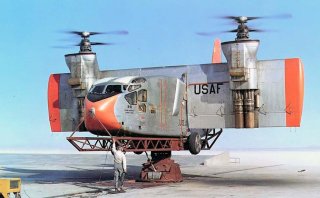The Rise and Fall of the Hiller X-18
In the late 1950s, the pioneering X-18 "Propelloplane" marked an ambitious foray into tiltwing and V/STOL technology for the U.S. Air Force. Built from assorted aircraft parts, including contra-rotating propellers and powerful turboprop and turbojet engines, the X-18 embarked on 20 test flights that uncovered significant challenges, such as sensitivity to wind gusts and critical engine linkage issues.
Summary: In the late 1950s, the pioneering Hiller X-18 "Propelloplane" marked an ambitious foray into tiltwing and V/STOL technology for the U.S. Air Force. Built from assorted aircraft parts, including contra-rotating propellers and powerful turboprop and turbojet engines, the X-18 embarked on 20 test flights that uncovered significant challenges, such as sensitivity to wind gusts and critical engine linkage issues. Despite a precarious incident that ended its flying career, the X-18 contributed valuable insights into engine cross-shafting and propeller pitch control, directly influencing the development of modern tiltrotor aircraft like the CV-22 Osprey, demonstrating the legacy of early experimental ventures in aviation.
Today, tiltrotor and vertical/short takeoff and landing technology, or V/STOL, is no longer novel – even if it still falls short of commonplace. But 60 years ago, at the height of aerospace experimentation, this technology was an especially dangerous and inspiring prospect.
In the late 1950s, the U.S. Air Force began experimenting with tiltwing and V/STOL technology through the development of a single testbed aircraft, the Hiller X-18. Design on the aircraft began in 1955, when Stanley Hiller Jr. and the Hiller Aircraft Corporation received a contract for what would become the only X-18 ever built: serial number 57-3078.
Introducing the Hiller X-18
Hiller chose to build the X-18 with parts scavenged from a Chase YC-122C Avitruc fuselage, as well as turboprops from a Lockheed XFV-1 and Convair XFY-1 Pogo experimental fighter. The result was a Frankenstein’s monster of an aircraft, featuring tri-bladed contra-rotating propellers that measured 16 feet across.
The new aircraft measured 63 feet long with a 48-foot wingspan and 24-foot height. The total wing area was 528 square feet, with an aspect ratio of 4.36. The X-18’s empty weight was 27,052 pounds, with a max takeoff weight of 33,000 pounds. The aircraft had a fuel capacity of 1,000 gallons.
The aircraft relied on two Allison T40-A-14 coupled turboprop engines, each of which could provide 5,850 horsepower, and one Westinghouse J34 turbojet engine, which offered 3,400 pounds of thrust for jet reaction pitch control. To control the aircraft’s pitch at low speeds, the X-18’s Westinghouse turbojet engine diverted its exhaust upward and downward at the tail.
For public relations purposes, Hiller nicknamed their X-18 the “Propelloplane” – and began testing.
Testing the X-18
The Hiller X-18’s initial testing location was Moffett Field Naval Air Station in California. The first flight was taken on Nov. 20, 1959. It was just a short hop, and it went well. Four days later, the X-18 was taken for its first proper flight, with Hiller test pilots George Bright and Bruce Jones at the controls. The X-18 performed well enough, and further test flights were held at Edwards Air Force Base.
In all, 20 flights were taken, and they revealed a nagging set of problems. For example, the X-18 was acutely vulnerable to wind gusts while the wings were tilting. The wings became a functional sail, capable of catching the wind unintentionally. Also, the turboprop engines were not cross-linked, meaning the failure of just one engine would cause the X-18 to crash. The X-18 proved difficult to handle – thrust control was made through throttle changes, which were too slow for passable height and roll control.
The X-18’s 20th flight was her last for a reason. At 10,000 feet, while attempting to convert into a hovering configuration, the aircraft plunged into a spin. The crew was able to exit the spin and safely land the aircraft, but the finicky X-18 was never flown again.
While the aircraft made just 20 flights and has long since faded into aviation obscurity, the Hiller X-18 made meaningful contributions to the development of tiltrotor and V/STOL flight. First, the X-18 demonstrated that cross-shafting between the engines was necessary to avoid the loss of control should an engine fail. Second, the X-18 demonstrated that direct propeller pitch control was necessary for precise height and lateral control during V/STOL and hover operations. The lineage of the X-18 is in service today, in the form of the CV-22 Osprey.
About the Author: Harrison Kass
Harrison Kass is a defense and national security writer with over 1,000 total pieces on issues involving global affairs. An attorney, pilot, guitarist, and minor pro hockey player, Harrison joined the US Air Force as a Pilot Trainee but was medically discharged. Harrison holds a BA from Lake Forest College, a JD from the University of Oregon, and an MA from New York University. Harrison listens to Dokken.


